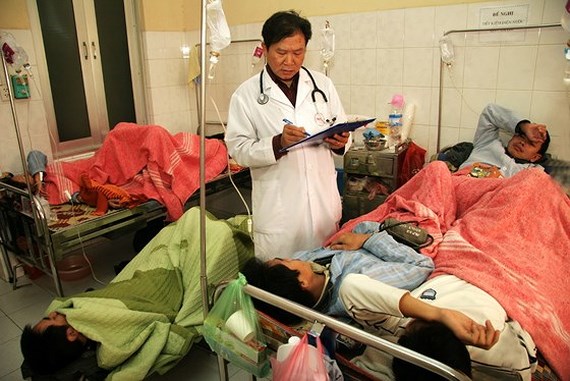
Vietnam will tackle overloaded hospitals with two or three patients in one bed (Photo: SGGP)
According to leaders of the ministry, last year, the sector continued to adopt measures to improve examination and treatment quality focusing to fight patient overload in big hospitals. PAPI, or Vietnam Provincial Governance and Public Administration Performance Index, showed that district-level infirmaries have improved much the treatment quality; consequently, residents are more satisfactory with medical service.
The network of satellite hospitals is expanded in 63 cities and provinces across the country. Central hospitals have transferred medical hi-techniques to its satellite infirmaries; subsequently, fewer cases have been transferred to big facilities.
Moreover, test results carried out by a hospital will be used by other hospitals as one of the Ministry of Health’s project. Additionally, more hospitals will apply PACS, or picture archiving and communication system (a medical imaging technology used for storing, retrieving, presenting and sharing images produced by various medical hardware modalities, such as X-ray, CT scan, MRI and ultrasound machines) to cut cost for patients and increase efficiency as the Ministry’s project.
At present, seven hospitals are approved to apply PACS and ten others will be given the green light to carry out the project. This move gradually control services provided by private companies for patients’ benefit.
Furthermore, the Ministry will have regulation on technique procedures in Anesthesiology, Gastroenterology, Trauma and Orthopedics and Nerve departments. Some 6,389 over 17,216 technique procedures have been built up so far and they are most popular ones. Besides, hospitals are as quick as possible to adopt treatment guidance for common diseases in hospitals; therefore, hospitals in Ho Chi Minh City have over 2,000 treatment guidance for each popular disease.
Noticeably, changes have seen in hospitals. Nevertheless, infirmaries achieved 2.75 points over 5 nationwide yet they must reach three points. As per the assessment of the the Medical Examination and Treatment Department under the Ministry of Health, it is acceptable with such points in the country’s current context of medical facilities.
Along with this, patient satisfaction survey and medical workers’ behaviors have been conducted in hospitals. Initially, they provided useful information helping hospitals know what to be top priority to improve quality.
Many clinics adopted online patient satisfaction survey system to measure patients’ opinion on treatment services; just in one year implementation, hospitals have collected over one million questionnaires showing the rate of inpatient and outpatient satisfaction of medical services is 75.6 percent and 66.3 percent.
According to the Ministry of Health’s self-assessment of treatment quality, treatment quality can not meet increasing demand and there are a big gap between hospitals in different districts; as a result, people come to large hospitals in big cities for examination and treatment. District -level clinics are able to cure ailment not able to provide comprehensive taking care of patients.
Worse, the country lacks clinics for senior patients, for patients with non-communicable diseases, and biological research facilities. Treatment paperwork for insured patients in some localities confused patients and medical workers’ behavior is not suitable. Security in hospitals is not good.
The combination between modern and traditional medicine in some institutions is not as expectation because people belittle traditional medicine.
Hence, the Ministry is determined to push up measures to reduce patient overload in 2018 especially in big cities such as Ho Chi MInh City, Hanoi, and central cities and provinces.
Best of all, the Ministry will improve its regulations to enhance treatment quality supervision. It will set up teams to test treatment quality and present certificates to good facilities. Around 20 percent of hospitals in central provinces will be tested and the Ministry will announce its results in 2018.
The Ministry will correct medical workers’ behaviors to achieve patients’ satisfaction so that 80 percent facilities will gain patients’ pleasure. The sector will reform paperwork in treatment procedure. Gradually, over half of hospitals from grassroot hospitals will conduct one-door paperwork.
SGGP News
 Vietnam to pilot online tax declaration portal this month ahead of 2026 rollout
Vietnam to pilot online tax declaration portal this month ahead of 2026 rollout



